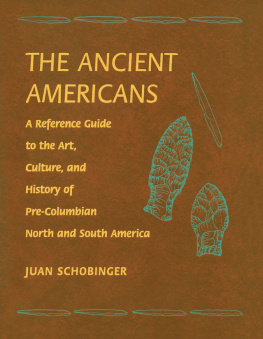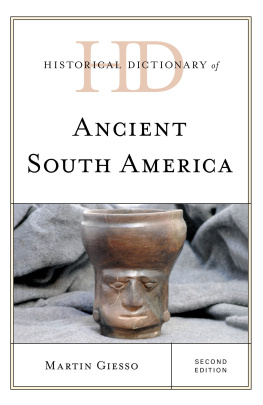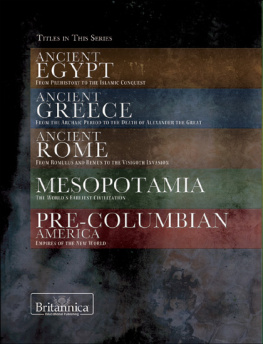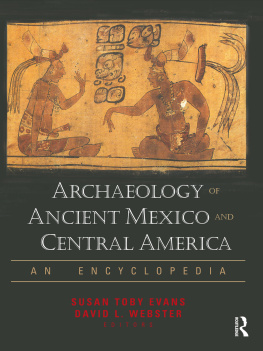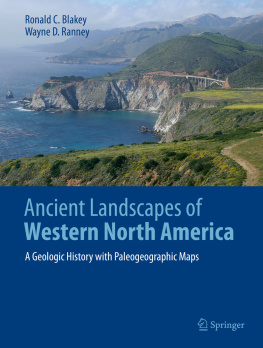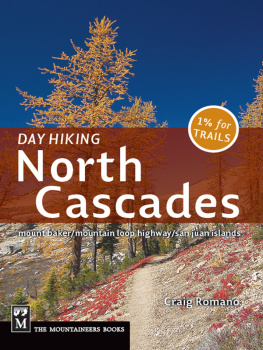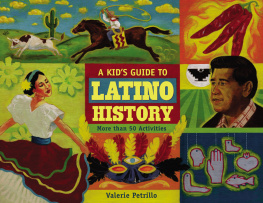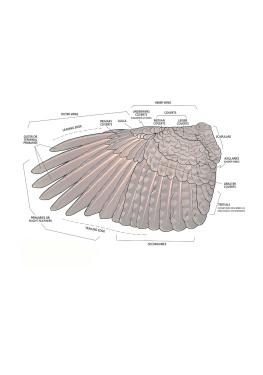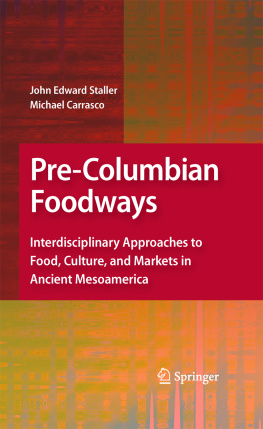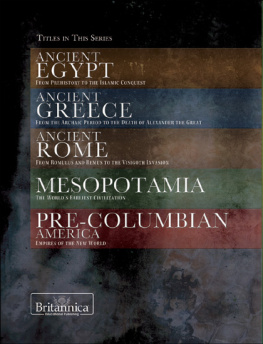THE ANCIENT AMERICANS
Volume I
JUAN SCHOBINGER has a Ph.D. in Philosophy and Letters from the University of Buenos Aires, Argentina. He was a full professor of Archaeology and Prehistory at the University of Cuyo in Mendoza, Argentina, from 1957 until his retirement in 1994, when he became Professor Emeritus. Dr. Schobinger also taught courses in Anthropology and Ancient History of the East. His main research areas are South American pre-ceramic cultures, cave art, and Inca archaeology. He is the author of five books.
The Ancient Americans
A Reference Guide to the Art, Culture, and History of Pre-Columbian North and South America
Volume I
Juan Schobinger
Translation: Carys Evans-Corrales
University of Pittsburgh at Bradford
Consultant: Susan Kart
Columbia University
First published 1997 by M.E. Sharpe
Published 2016 by Routledge
2 Park Square, Milton Park, Abingdon, Oxon OX14 4RN
711 Third Avenue, New York, NY 10017, USA
Routledge is an imprint of the Taylor & Francis Group, an informa business
2001 Taylor & Francis.
Copyright 1997
by Editoriale Jaca Book spa, Milano
No part of this book may be reprinted or reproduced or utilised in any form or by any electronic, mechanical, or other means, now known or hereafter invented, including photocopying and recording, or in any information storage or retrieval system, without permission in writing from the publishers.
Notices
No responsibility is assumed by the publisher for any injury and/or damage to persons or property as a matter of products liability, negligence or otherwise, or from any use of operation of any methods, products, instructions or ideas contained in the material herein.
Practitioners and researchers must always rely on their own experience and knowledge in evaluating and using any information, methods, compounds, or experiments described herein. In using such information or methods they should be mindful of their own safety and the safety of others, including parties for whom they have a professional responsibility.
Product or corporate names may be trademarks or registered trademarks, and are used only for identification and explanation without intent to infringe.
Library of Congress Cataloging-in-Publication Data
Schobinger, Juan.
[Arte prehistrico de Amrica. English]
The Ancient Americans: a reference guide to the art, culture, and history of
pre-Columbian North and South America / Juan Schobinger.
p. cm.
Includes bibliographical references and index.
ISBN 0-7656-8034-3 (set: alk. paper)
1. Rock paintingsAmerica. 2. PetroglyphsAmerica. 3. IndiansAntiquities.
4. Indian Art. 5. AmericaAntiquities. I. Title.
E59.P42 S3613 2000
970.01dc21
00-056280
Translated from Spanish by
Carys Evans-Corrales
Cover Design: Lee Goldstein
ISBN 13: 978-0-7656-8034-1 (hbk)
Table of Contents
This book is devoted to the ancient hunter-gatherers and the first farmers on the continents of North and South America.
People have always been interested in early civilizations and their origins, but systematic research on the subject has only been carried out for a few decades. An overview of these first settlers of the two continents is still very incomplete. It is also controversial, given the debates over how long ago these peoples lived here; but we may still put forward some new ideas to replace the outdated theories of the first half of the twentieth century.
The main artistic legacy of the prehistoric hunters and farmers of the Americas is their cave art. In most instances we do not know the dates when particular examples of cave art were executed, and many of the dates given to them are hypothetical, but there are still strong clues as to the cultural groups to which ancient hunters belonged. The old farming communities, both the ancient and relatively recent ones in areas that are on the fringes of civilizations (and which are generally classifiable as "American Neolithic"), have also created rich and varied cave drawings, which also deserve to be included. The second part of this work is therefore devoted to these farming communities, but the reader should understand that the illustrations are taken from such an extraordinary mass of sites and motifs that they could have taken up several volumes.
This set is intended, therefore, both as an introduction to the most ancient prehistory of the Americas and as a general presentation of its prehistoric art, especially that of the hunting communities and ancient farmers. It also includes information on early phases of its great civilizations, with special emphasis on their cave art. It covers cave art from ancient times to roughly 1000 to 1200 C.E. (Common Era, or since the year 0), some 300 to 500 years before the first voyage of Christopher Columbus. This set was created primarily as a documentary and descriptive tool. It is not intended to go into detail over methodological problems or technical, aesthetic, or philosophical arguments. Nor does it analyze the controversy that surrounds the concept of style.
I would like to express my profound gratitude to those colleagues who have kindly provided me with illustrations for possible inclusion in this work. Very special thanks are due to Julio Ferrari, a technician attached to the Argentine National Council on Scientific and Technological Research, who is also a laboratory technician at the Institute of Archaeology at our university. Julio Ferrari has carried out patient and painstaking work in preparing the numerous drawings that form the illustrations for this book. I am also grateful to Editoriale Jaca Book, and to its editor, Dr. Sante Bagnoli, for his invitation to work on this project.
Chapter I
Introduction
The study of every great historical and cultural process requires a placement in space. Without stating that everything is determined by geography, it must nevertheless be said that the earth is not only the scene of history but also its very foundation. The distribution and characteristics of the continents are factors that cannot be ignored in the destiny of the human groups that move upon them.
The details of the geography of the Americas may be seen in any atlas. What we call the Western Hemisphere is actually formed by two continents that happen to be linked by the Isthmus of Panama, and which were submerged until the end of the Tertiary Period (about 65 to 100 million years ago). The first of these continents, North America (which includes Central America), is separated from northeast Asia today by the Bering Strait. The coastlines and islands of Canada lie to the north, bathed by the glacial Arctic Sea. The tundra-style vegetation of northeast Asia covers the west into the Siberian regions. This is the habitat of some of the world's hardiest people, those who have adapted best to extreme conditions: the Inuit peoples, previously known as the Eskimos, who originated in the north of Asia. Further to the south lies a wide region characterized by pine forests, which cover almost the whole of Canada. The western part is mountainous, descending through its rainy, island-studded coastline to the Pacific. The great temperate swath that followscorresponding approximately to today's United Statespresents a greater variety of environments: forests, open lands, deciduous trees to the east, and prairie and partial steppea vast, arid, largely treeless expansein the center. West of the Mississippi River stand the Rocky Mountains, which stretch from Canada to the south, and whose vegetation is similar to that of the European Alps.

